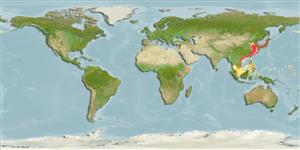Elasmobranchii (Haie und Rochen) (sharks and rays) >
Rajiformes (Skates and rays) >
Rajidae (Skates)
Eponymy: The original description has no etymology, but the binomial is not an eponym: it is derived from the Japanese name for the skate, which is keno-ei. (See Zuge for a similar case). (Ref. 128868), visit book page.
Environment: milieu / climate zone / depth range / distribution range
Ökologie
seewasser demersal; ozeanodrom (Ref. 51243); tiefenbereich 20 - 230 m (Ref. 106604). Temperate
Northwest Pacific: Japan, Korea and Taiwan (Ref. 8630). Appears to be confined to the continental shelf off Japan and in the China Seas south to about Xiamen (Ref. 47737).
Length at first maturity / Size / Gewicht / Alter
Maturity: Lm ?, range 39 - ? cm
Max length : 57.0 cm TL Männchen/unbestimmt; (Ref. 111281); max. veröff. Gewicht: 815.70 g (Ref. 125279)
Bottom-dweller that feeds on invertebrates and bony fish. Oviparous. Distinct pairing with embrace. Young may tend to follow large objects, such as their mother (Ref. 205). Eggs are oblong capsules with stiff pointed horns at the corners deposited in sandy or muddy flats (Ref. 205). Egg capsules are 4.8-6.6 cm long and 2.9-3.7 cm wide (Ref. 41249, 41253, 41298). Depth range given by H. Ishihara (pers.comm. 07/07).
Oviparous, paired eggs are laid mainly at night (Ref. 44760). Batches of eggs are laid in three to six-day interval on sand bottom. Embryos feed solely on yolk (Ref. 50449). Distinct pairing with embrace. Young may tend to follow large objects, such as their mother (Ref. 205).
McEachran, J.D. and K.A. Dunn, 1998. Phylogenetic analysis of skates, a morphologically conservative clade of elasmobranchs (Chondrichthyes: Rajidae). Copeia 1998(2):271-290. (Ref. 27314)
IUCN Rote Liste Status (Ref. 130435: Version 2024-1)
Nutzung durch Menschen
Fischereien: kommerziell
Tools
Zusatzinformationen
Download XML
Internet Quellen
Estimates based on models
Preferred temperature (Ref.
123201): 9.8 - 26, mean 22 °C (based on 123 cells).
Phylogenetic diversity index (Ref.
82804): PD
50 = 0.5001 [Uniqueness, from 0.5 = low to 2.0 = high].
Bayesian length-weight: a=0.00282 (0.00173 - 0.00459), b=3.23 (3.09 - 3.37), in cm total length, based on LWR estimates for this species & (Sub)family-body (Ref.
93245).
Trophic level (Ref.
69278): 3.4 ±0.5 se; based on diet studies.
Widerstandsfähigkeit (Ref.
120179): niedrig, Verdopplung der Population dauert 4,5 - 14 Jahre. (Fec = 40-150;).
Fishing Vulnerability (Ref.
59153): Moderate vulnerability (43 of 100).
